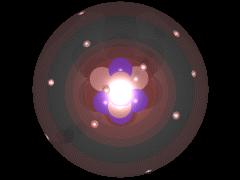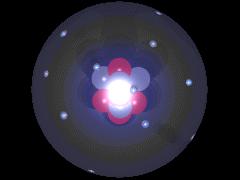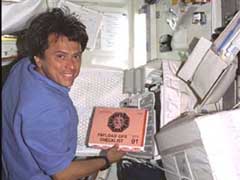pop up description layer
HOME
Cryptozoology UFO Mysteries Aviation Space & Time Dinosaurs Geology Archaeology Exploration 7 Wonders Surprising Science Troubled History Library Laboratory Attic Theater Store Index/Site Map Cyclorama
Search the Site: |
|
Where is all the AntiMatter?
All material that we see, taste and touch is made up of tiny particles called atoms. The atom is the smallest portion of an element, such as lead, oxygen, or carbon, that is still considered to be that element. In the center of the atom is a nucleus composed of two types of particles called protons and neutrons. Surrounding the nucleus is a cloud of swarming particles called electrons. Protons have a positive electrical charge, electrons a negative charge and neutrons, as the name suggests, are neutral in charge. Suppose, though, that the protons of an atom were negatively charged and the electrons positively charged? What would we have then? The answer is antimatter. Material, like we see all around us, but with a reversed charge. The problem is that it isn't all around us. While scientists have produced tiny amounts of antimatter in laboratories, it doesn't seem to exist in large quantities anywhere in the universe. When matter and antimatter come into contact they "annihilate" each other and turn into a burst of energy (gamma rays to be exact). Because of this, it is easy for scientists to tell that no significant mass of antimatter exists in our solar system. If the sun were made of antimatter, the solar wind (particles shot off from the sun) would generate gamma rays when they hit the Earth. The same is true for all the planets. If Mars were made of antimatter the gamma rays from annihilation as the solar wind hit would be easily detectable.
Using the same logic, scientists can infer that no significant amount of antimatter exists in our galaxy, or our local cluster of galaxies or even our supercluster of galaxies. (A supercluster of galaxies is a group of galaxies about 100 million light years wide.) Yet, it should be there. When matter is created from energy, as scientists believe happened in the very early universe, antimatter is also created. A proton cannot be created without also getting an oppositely-charged antiproton. The same is true for electrons (the antimatter version of an electron is called a positron). The universe is a big place, and perhaps there is a chance that the antimatter exists somewhere out beyond our local galactic supercluster (perhaps there are whole galaxies and galactic superclusters made of nothing but antimatter) but there are no good theories about how it could get so far separated from the matter. Some scientists and NASA tried to resolve this riddle by using an experiment aboard a space shuttle in 1998 to try and detect the cosmic rays (atoms and parts of atoms traveling through space) that may have originated in an antimatter portion of the universe. No significant amount of these were found. The few sources of antimatter that were detected seemed to come from the core of energetic galaxies or quasars (which are probably black holes that generate small amounts of antimatter as they suck regular matter into themselves). None of the sources detected was antimatter left over from the creation of the universe. How can this be possible given that when matter is created, so an equal portion of antimatter should also be created? Some experiments have suggested that antimatter may behave slightly differently than matter. In the very hot and energetic early universe where energy was coalescing into matter and antimatter and then annihilating back into energy, a tiny portion of the antimatter may have decayed before it could annihilate with matter. The tiny portion of matter (perhaps as few as 1 particle out of 100 million) left over would account for the entire universe we now see - planets, moon, stars, and galaxies.
Still, some scientists think that there might be large sections of universe made from antimatter. To try and settle this matter, NASA will use the new Alpha Magnetic Spectrometer (AMS) scheduled to be installed on the International Space Station in 2002 or 2003. This AMS is designed to look for relatively heavy antimatter -- anti-helium nuclei or particles even more massive, such as anti-carbon, that may come zipping through our solar system from far away antimatter galaxies. Finding massive antimatter particles would be important because normal high-energy particle interactions involving regular matter don't usually produce heavyweight antimatter such as anti-helium or anti-carbon. Such heavy antimatter would most likely have been left over from the creation of the universe, suggesting that somewhere out there is a mass of antimatter that has so far gone undetected. Copyright Lee Krystek 2001. All Rights Reserved. |
|
Related Links |
|
|







